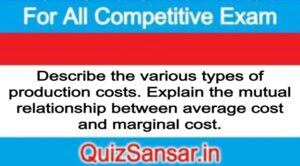
Describe the various types of production costs. Explain the mutual relationship between average cost and marginal cost.
Describe the various types of production costs. Explain the mutual relationship between average cost and marginal cost.
Or
What do you understand by cost ? Describe the various types of production costs.
Ans.
Concept of Cost
Output needs inputs. Broadly, there are two types of inputs (i) factor inputs (land, labour, capital & entrepreneurship, called factors of production), and (ii) non-factor inputs (raw material). Cost refers to the expenditure incurred by a producer on the factor as well as non factor inputs for a given output of a commodity.
Cost refers to the expenditure incurred by a producer (explicitly or implicitly) on the factor as well as non factor inputs for a given output of a commodity.
Explicit and Implicit Cost
All inputs may not be purchased from the market. A producer may use some self-owned inputs. Example- Instead of hired workers from the market, producer may use his family labour Likewise, a producer may use his own land instead of taking it on lease. Expenditure incurred by the producer on the purchase of inputs from the market is called explicit cost. Estimated. expenditure on the use of self-owned inputs is called implicit cost. In economics total cost is estimated considering both elements. Viz. explicit cost and implicit cost.
Total Cost-Explicit Cost + Implicit Cost
It is significant to note that in economics, cost is always measured as opportunity cost. And we know that opportunity cost of an activity is measured in terms of the total sacrifice involved in undertaking that activity. Thus, cost of producing a given amount of output is to be measured in terms of the sacrifice involved in producing that output. From the producer’s point of view (or the firm’s point of view), the sacrifice involved in producing a given amount of output includes.
(i) Explicit cost, and
(ii) Implicit cost of production.
A glance at the following flow chart should bring further clarity on this point.
Explicit Cost and Implicit Cost-the Difference
Explicit Cost
(i) It is the opportunity cost of purchasing inputs from the market.
(ii) It is measured in terms of cash payments that a firm makes to others for the purchase of inputs.
Example: Wages paid to the workers, payment of electricity bill.
Implicit Cost
(i) It is the opportunity cost of using self owned inputs.
(ii) It is measured in terms of imputed costs (or estimated costs) of the self-owned and self employed resources.
Example: Estimated rent on entrepreneur’s own building, estimated interest or entrepreneur’s own capital.
Short Run Costs- Short run is a period of time during which some factors are fixed and some are variable. Accordingly, short run costs have two components. Viz., (1) fixed costs, referring to expenditure on fixed factors, and (2) variable costs referring to expenditure on variable factors.
(1) Fixed Costs
Costs related to the use of fixed factors are known as fixed costs.
Fixed costs are the costs related to the use of fixed factors of production.
These are also called supplementary costs, or overhead costs or indirect costs. These costs do not change with the change in output. Fixed costs are incurred even when output is zero. Let us take an illustration. In a carpet manufacturing firm, a machine is installed as a fixed factor. Let us assume that it can make 6 carpets a day and that the cost of hiring the machine is Rs. 500 per day. Obviously, Rs. 500 per day is the fixed cost that the producer has to incur even when no carpet is made in a day. Between 0-6 carpets in a day, the fixed cost would remain Rs. 500.
(2) Variable Costs
Variable costs are those costs which are related to the use of variable factors.
Variable costs refer to the expenditure incurred by the producer on the use of variable factors of production.
Variable costs change with a change in the volume of output. As output increases, these costs also increase and as the output decreases, these costs also decrease. When output is zero, these costs are also zero. These costs are called Prime Costs or Direct Costs.
(3) Average Costs- Cost per unit of output is called average cost. In other words, Average cost is the cost per unit of output produced. It is also called unit cost of production.
AC= TC/Q
(4) Marginal Cost- Marginal cost is the change in total cost when an additional unit of output is produced. According to Ferguson, “Marginal cost is addition to the total cost due to the addition of one unit of output.”
MCn=TCn-TCn-1
or
MC= △TC/△Q






